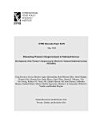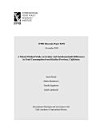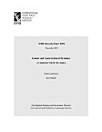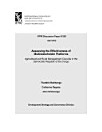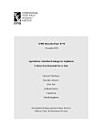Nutrition-sensitive agriculture diversification and dietary diversity: Panel data evidence from Tajikistan
Takeshima, Hiroyuki · Lambrecht, Isabel · Akramov, Kamiljon · Ergasheva, Tanzila
apr. 2024 · IFPRI Discussion Papers Bok 2249 · Intl Food Policy Res Inst
E-bok
48
Sidor
family_home
Kvalificerad
info
reportBetyg och recensioner verifieras inte Läs mer
Om den här e-boken
Nutrition-sensitive agricultural diversification continues to receive interest among developing country stakeholders as a viable option for achieving dual goals of poverty reduction and food/nutrition security improvements. Assessing the effectiveness of this strategy is also essential in countries like Tajikistan. We attempt to enrich the evidence base in this regard. We assess the linkages between household-level agricultural diversification and dietary diversity (both household- and individual-levels) using unique panel samples of households and individual women of reproductive ages in the Khatlon province. Using difference-in-difference propensity-score methods and panel fixed-effects instrumental variable regressions, we show that higher agricultural diversification together with greater overall production per worker and land at the household level leads to higher dietary diversity, particularly in areas with poor food market access. Typology analyses and crop-specific analyses suggest that vegetables, fruits, legumes/nuts/seeds, dairy products and eggs are particularly important commodities for which a farmer’s own production contributes to dietary diversity improvement. Furthermore, decomposition exercises within the subsistence farming framework suggest that nutritional returns and costs of agricultural diversification vary across households, and expected nutritional returns may be partly driving the adoption of agricultural diversification. In other words, households’ decisions to diversify agriculture may be partly driven by potential nutritional benefits associated with enhanced direct on-farm access to diverse food items rather than farm income growth alone. Our findings underscore the importance of supporting household farm diversification in Tajikistan to support improved nutrition intake, especially among those living in remote areas. In a low-income setting with limited local employment opportunities that is vulnerable to a wide range of external shocks, this will likely continue to be one of the most straightforward and realistic paths to improving household’s nutrition resilience.
Betygsätt e-boken
Berätta vad du tycker.
Läsinformation
Smartphones och surfplattor
Installera appen Google Play Böcker för Android och iPad/iPhone. Appen synkroniseras automatiskt med ditt konto så att du kan läsa online eller offline var du än befinner dig.
Laptops och stationära datorer
Du kan lyssna på ljudböcker som du har köpt på Google Play via webbläsaren på datorn.
Läsplattor och andra enheter
Om du vill läsa boken på enheter med e-bläck, till exempel Kobo-läsplattor, måste du ladda ned en fil och överföra den till enheten. Följ anvisningarna i hjälpcentret om du vill överföra filerna till en kompatibel läsplatta.




